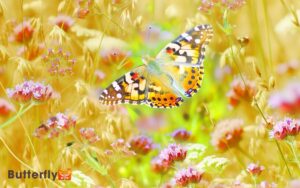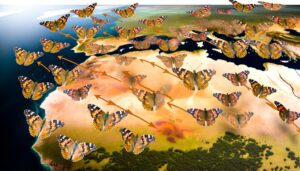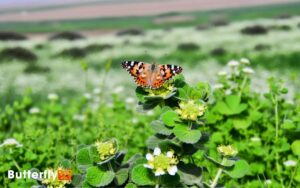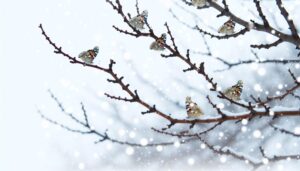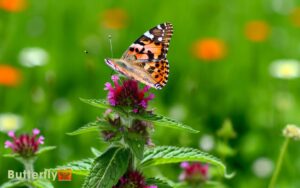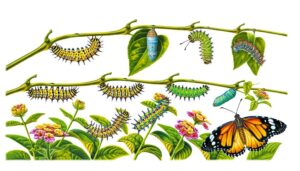Painted Lady Butterfly Care Instructions: Essential Tips!
Caring for Painted Lady butterflies entails providing ample space for flight and maintaining temperatures between 70-85°F.
Natural light supports their circadian rhythms, and plants offer perching sites. A diet of fresh flowers, a sugar water solution (1:10 ratio), fruit slices, or commercial nectar is essential.
Each life stage egg, larva, pupa, and adult requires specific monitoring, with the egg stage lasting 3-5 days, larva 7-10 days, and the adult stage 2-4 weeks. Weekly habitat cleaning and daily food replacement prevent bacterial growth.
Release butterflies on a warm, sunny day in an area rich with nectar-producing flowers. For more detailed care techniques, those studying should continue.
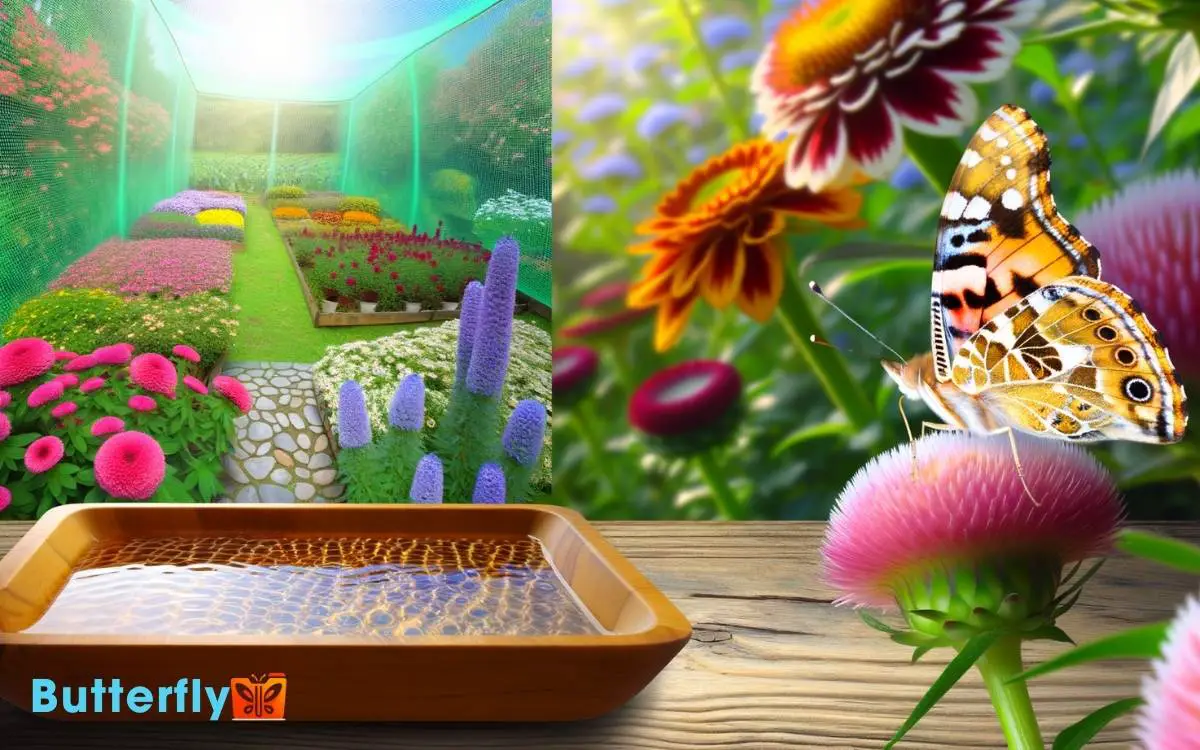
Key Takeaways
Selecting the Right Habitat
To ensure the well-being of Painted Lady butterflies, one must carefully select a habitat that provides ample space, appropriate temperatures, and access to natural light. A spacious enclosure allows for unrestricted flight, essential for their physical health.
The ideal temperature range is between 70-85°F, ensuring metabolic processes function at their best. Natural light is essential for regulating their circadian rhythms, promoting overall vitality.
The habitat should also include plants, providing perching sites and mimicking their natural environment.
Avoid direct exposure to harsh sunlight or artificial lights, which can cause stress. Proper ventilation is necessary to maintain air quality, reducing the risk of mold and disease. Selecting the right habitat is foundational to their survival and flourishing.
Feeding Requirements
Feeding Painted Lady butterflies requires a diet rich in nectar, which they typically obtain from a variety of flowering plants.
To make sure their nutritional needs are met, caretakers should provide:
- Fresh Flowers: Offer blooms such as daisies, marigolds, and zinnias, which are known to be favored by Painted Ladies.
- Sugar Water Solution: Mix one part sugar to ten parts water to mimic nectar. Change frequently to prevent fermentation.
- Fruit Slices: Provide pieces of overripe fruit like bananas, oranges, or melons, which supply essential sugars and moisture.
- Commercial Nectar: Purchase specialized butterfly nectar from reputable suppliers to guarantee a balanced diet.
Proper nourishment is essential for their health and longevity, facilitating active behavior and successful reproduction.
Monitoring the Life Cycle
Caretakers must closely monitor the Painted Lady butterfly’s life cycle, from egg to adult, to guarantee they provide appropriate care at each developmental stage.
Observing the changes ensures that each stage receives the necessary environment and nutrition. Painted Lady butterflies go through four main stages: egg, larva (caterpillar), pupa (chrysalis), and adult.
Each stage has unique requirements and durations, which are detailed below:
| Stage | Duration | Key Observations |
|---|---|---|
| Egg | 3-5 days | Tiny, green, laid on leaves |
| Larva | 7-10 days | Growing, molting, feeding |
| Pupa | 7-10 days | Immobile, transformation |
| Adult | 2-4 weeks | Mating, laying eggs |
Ensuring Proper Hygiene
Maintaining a clean environment throughout each stage of the Painted Lady butterfly’s life cycle is vital for preventing disease and ensuring healthy development. Regular hygiene practices are essential, as contaminants can easily affect the larvae and adult butterflies.
To guarantee proper hygiene, one should:
- Clean the habitat weekly: Remove any waste, old food, and shed skins to reduce bacterial growth.
- Sanitize tools and containers: Use a mild bleach solution (1:10 ratio) to disinfect equipment regularly.
- Replace food daily: Fresh food minimizes mold and bacterial contamination.
- Monitor humidity levels: Keep humidity between 40-60% to prevent mold, which can harbor harmful pathogens.
These steps help maintain a healthy environment, promoting the well-being of Painted Lady butterflies.
Preparing for Release
As the Painted Lady butterflies near the end of their life cycle, it’s crucial to prepare them for a safe and successful release into their natural habitat.
First, choose a warm, sunny day with minimal wind, as these conditions enhance flight success. Select a location rich in nectar-producing flowers like asters, coneflowers, and milkweed to provide immediate food sources.
Handle the butterflies gently by letting them crawl onto a finger or leaf, reducing stress and potential wing damage. Release them during mid-morning when temperatures are best for flight. Avoid releasing them near busy roads or areas with high pesticide use.
Observing these steps ensures the butterflies have the best chance to thrive and contribute to the ecosystem.
Conclusion
Caring for a painted lady butterfly is like choreographing a delicate dance. By selecting the right habitat, providing proper nutrition, monitoring their life cycle, and maintaining impeccable hygiene, enthusiasts can guarantee these butterflies thrive. A crucial stage in this process is carefully observing the painted lady butterfly cocoon, ensuring it remains undisturbed in a safe environment. During this time, maintaining the right humidity and temperature can significantly impact the butterfly’s successful emergence. Once it hatches, providing fresh nectar sources will support its health and longevity.
Each step, from egg to release, requires precision and dedication. As they flutter away, one can feel a sense of accomplishment, knowing they’ve contributed to the well-being of these intricate creatures.
This meticulous care mirrors the commitment essential in scientific endeavors.

